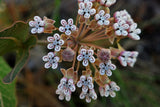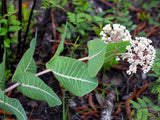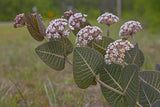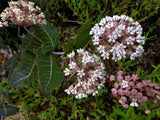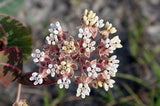Asclepias humistrata Seeds — “Sandhill Starlight: A Monarch’s Stage”
Sow the essence of sun-drenched scrub and whispering pine barrens with Asclepias humistrata—known as Sandhill, Pinewoods, or Pink‑Veined Milkweed. These seeds are a portal to sandy landscapes alive with fluttering wings, ancient symbolism, and delicate pink-lavender constellations of blooms.
1. A Name Warmer than Sand
Asclepias, named for the Greek god of healing, carries a legacy of botanical reverence. Humistrata literally means “sprawling on the ground,” a nod to its gracefully prostrate habit. Native to the southeastern United States—from North Carolina to Louisiana—this prairie-dancer thrives in sandhills, scrub, and dry pine flatwoods.
2. Petals Painted in Sunrise Hues
Its umbels bloom in shades of delicate pink, lavender‑white, or soft purple, with reflexed petals and cream‑white hoods that seem sculpted by dew. These star-like flowers appear in spring through early summer—sometimes lingering sporadically well into the heat of July.
3. True Survivor: USDA Zones & Soil Sense
Adapted to sun-scorched, lean soils, this milkweed flourishes in USDA Zones 8a–9b, with some sources noting success from Zones 6–10 in well-draining sites. Once established, it withstands drought yet recoils from overly rich or moist soils.
4. A Monarch’s Meadow & Pollinator Promise
Not just nectar, but home—Sandhill Milkweed stands as a vital larval host to Monarch and Queen butterflies, who lay their eggs upon its pink-veined leaves despite their toxic defense. It draws a parade of wildlife—bees, butterflies, hummingbirds, moths, and even predatory insects—transforming your garden into a stage for ecological drama.
5. Wonder Threads from Nature’s Tapestry
-
Leaf Vein Drama: The thick, clasping leaves—blue-green to gray-green—are veined in vivid pink to purple, intensifying in color as they age and become a textural feast for the eye.Deep Taproot Tenacity: A long taproot anchors it deep in dry soil—a secret to its survival and challenge to transplanting; seed propagation is the gardener’s true path.Silken Seeds of Flight: After blooming, pods split open—releasing seeds each trailing silky fibers (comas) that drift like summer whispers.Fire’s Ally: In fire-managed ecosystems like sandhills and pine barrens, this milkweed often regrows resiliently from its deep root, testifying to survival in scorched landscapes.
Product Summary — “Sandhill Starlight” Seeds
| Feature | Enchanting Detail |
|---|---|
| Bloom Colors | Pink, lavender-white, or pale purple umbels—floral stars in the dune sky |
| Fragrance | Subtle, not officially fragrant; the visual charm speaks loudest |
| Hardiness Zones | USDA Zones 8a–9b; some growers span 6–10 with good drainage |
| Growth Habit | Sprawling perennial, 1–3 ft tall and wide, with pink-purple-veined leaves |
| Wildlife Value | Larval host to Monarch & Queen butterflies; nectar for bees, hummingbirds, moths & more |
| Special Traits | Deep taproots, fire-adapted, silk-wind‑borne seeds, visually stunning veins |
Planting Whisper-Lines for Wild Elegance
-
Sow & Trust the Taproot: Directly sow in early spring or fall. Protect from disturbance once roots dive deep—this is not a plant for repotting.
-
Match Its Home: Choose full sun, sandy, well-draining soil. Avoid rich or water-retentive site.
-
Let the Seed Sky Dance: Save pods, open them gently, and watch the comas drift—nature’s dispersal at work.
-
Frame with Purpose: Enrich butterfly gardens, native landscapes, or pollinator corridors. Its sprawling nature invites thoughtful placement as both groundcover and centerpiece.
Grow Asclepias humistrata, and you awaken a silken symphony—milkweed stars shimmering amid sandy light, monarch wings trembling against violet veins, and a living tapestry that ties your garden to the wild. Let me know if you’d like companion planting ideas or tips for encouraging fluttering life!






